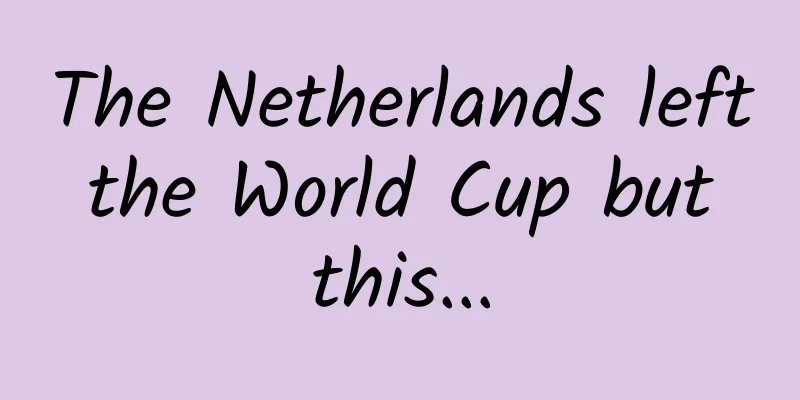The Netherlands left the World Cup but this...

|
In the World Cup, many countries' jerseys have their own iconic colors, such as the red Belgium, the Xinhua Dictionary-colored Portugal, the blue and white stripes Argentina, the orange Netherlands... Just this morning in the World Cup quarter-finals, the last two national teams mentioned above faced off and put on a very exciting showdown. Unfortunately, the Netherlands team was eliminated by one point. From the games to the jerseys, the Dutch team, known as the "Orange Army", has added a lot of color to the World Cup. In fact, orange is not only the color of the Dutch team's uniforms, but also the color loved by all the people in their country. It even directly influenced the color of carrots . Enthusiastic Dutch fans. Copyright image, no permission to reprint The carrots (Daucus carota var. sativa) we eat now have "var. sativa" in its scientific name, which means that it is a cultivated variety of wild carrots (Daucus carota). So what color are the roots of wild carrots? If the wild carrot is washed clean, its color is basically light yellow or light brown with a whitish tint . Compared with modern carrots, the roots of wild carrots appear thin and small. Although they can be eaten, their nutritional value is much lower. The process of wild carrots being domesticated into vegetables is also the process of its root color changing from monotonous to colorful. The yellowish roots of wild carrots, photo credit: thenorthwestforager.com Wild carrots are native to western Asia and have been domesticated for thousands of years. The earliest domesticated varieties had purple or yellow roots , and these two colors also represent two common plant pigments - anthocyanins and carotenoids . The purple color is brought by anthocyanidins, or more precisely, anthocyanins formed by anthocyanidins and sugars. They are found in many blue, purple, and purple-red plant tissues, such as blueberries, grapes, purple potatoes, purple eggplants, and purple cabbages. Anthocyanins are a type of water-soluble pigment, which means that purple carrots will easily fade when washed or cooked. Copyright image, no permission to reprint The yellow color comes from carotenoids, which is a general term for a class of substances with more than 700 kinds , mostly red, orange and yellow. The pigments in yellow carrots are mainly lutein, while the pigments in orange carrots are mainly α-carotene and β-carotene. Some reddish carrots are rich in lycopene. Carotenoids are fat-soluble substances, so they will not color the water when washing, but when they come into contact with oil in the pot, they will dye the oil orange-red. Copyright image, no permission to reprint If you took biology in high school, you probably still remember the horror of being governed by Mendel's laws of heredity . Today, Carrot will teach you a lesson and let you relive your student days. Because the carotenoid synthesis of most carrots can be seen as being controlled by two pairs of alleles (it can only be seen as such, but it is actually much more complicated), namely the Y gene and the Y2 gene. These two pairs of alleles will have the following three situations: 1. When the Y gene is dominant, no carotenoids are accumulated in the carrot roots, so they are nearly white, which is also the source of the color of wild carrot roots; 2. When the Y gene is homozygous recessive, then we have to look at the Y2 gene: if Y2 is dominant, then the carrot will only accumulate lutein and appear yellow; 3. If Y2 is also recessive homozygous, then the carrot can accumulate pigments such as lutein and β-carotene at the same time, appearing orange. If you feel dizzy, take a look at the following table: It is generally believed that carrots are divided into two cultivated varieties, the Eastern variety and the Western variety. The Eastern variety is reddish, and Beijing has a traditional variety called "whip red", which is a typical representative. The Western variety is yellowish and orange , and the orange variety is now sweeping the world and becoming the default color of carrots in many people's minds. This is thanks to the Dutch hundreds of years ago. The country we are talking about now, the Netherlands, should be more accurately called the Kingdom of the Netherlands. In the 16th century, the Netherlands was ruled by Spain, and later became independent under the leadership of Prince William of Orange (English: William of Orange Dutch: Willem van Oranje). William was therefore revered as the father of the Netherlands, known in history as William I. Some people believe that sweet orange was popular in Europe at that time and happened to have the same name as Orange, so William I also liked oranges and the color orange and used it as his symbol. After successfully founding the country, orange naturally became the representative color of the Dutch royal family and was loved by the people. Copyright image, no permission to reprint Soon after, horticulturists bred good-looking and delicious orange carrots. After the Netherlands became the "Coachman of the Sea" due to its developed maritime trade, it spread orange carrots to all parts of the world, establishing the stereotype that "carrots are orange vegetables." It was not until 1831 that German chemist Heinrich Wilhelm Ferdinand Wackenroder extracted an orange pigment from carrots and named it carotene . Although he did not describe in detail what kind of carrots he used, it is common sense to infer that it should be orange carrots with Dutch ancestry. Author: Wu Changyu Reviewer: Chen Ran, Associate Research Librarian (Science Communication) / Senior Engineer, COFCO Nutrition and Health Research Institute The cover image and the images in this article are from the copyright library Reproduction of image content is not authorized |
>>: UN report: One-third of World Heritage glaciers could disappear by 2050
Recommend
31 Lessons on Introverted Children: The Best Way to Raise Them: Dare to Express, Be Creative, and Be Confident
Do you often worry about having an introverted ch...
Short video APP product analysis report!
The structural framework of this article is shown...
Can the magical "gene scissors" bring new hope for curing AIDS?
Author: Duan Yuechu AIDS is a serious immune syst...
Case Study: A Specific App Retention Improvement Analysis Plan
This article mainly uses a case analysis to demon...
The world is so big, I want to eat – How can I eat healthier when I travel on vacation?
Author: Li Haijie: Hebei Provincial Key Laborator...
Marketing's key: consumer attention
Nowadays, it is difficult for consumers to concen...
Are Douyin stores and window displays the same? What are the connections and differences?
This article mainly introduces whether Douyin Stor...
It can be used to build warships and bring plants back to life...
END Tadpole Musical Notation original article, pl...
How does online education build a private traffic system?
Traffic costs are becoming more and more expensiv...
Skiing is fun, but you must also pay attention to safety
China Science and Technology News, December 28 (J...
The Double 11 marketing of this e-commerce company is a little different from that of Tmall and JD.com
Since the rapid development of the Internet indus...
The new national standard for liquor will be implemented next month, and these liquors are no longer liquor!
Experts of this article: Zou Jiangpeng, PhD in En...
Weibo Fans Advertising Copywriting Method and Placement Suggestions!
To run Weibo Fans Channel advertising , whether y...
Samsung is not alone: Apple phone explosion may trigger chain reaction
Throughout September, the explosion of Samsung No...
15 Brand Social Media Marketing Methodologies!
Marketing case analysis of hot new consumer brand...









